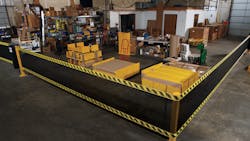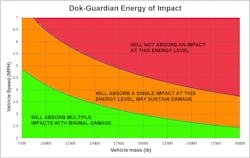Loading Docks and the ABC’s of Industrial Safety Barriers
A variety of safety challenges exist at loading docks, industrial facilities, distribution centers and storage facilities, especially when forklifts are operating among workers on foot. Injuries to workers or pedestrians can occur. Products can be damaged. Equipment can get damaged or destroyed.
To address these dangers, many facilities use visual cues or physical barriers (or a combination of both) as a safety solution. In some instances, these barriers simply may separate pedestrian traffic from other internal vehicle traffic. In other facilities, barriers may be employed to keep people away from automated processes and machinery, to protect employees against falls or to warn forklifts and pedestrians away from empty loading docks. Barriers also may be used to protect production equipment or the building itself from vehicle damage.
In all cases, barriers play an important role in helping facilities operate safely and efficiently. While the industry standard of 10,000 lbs. at 4 mph is a good starting point for selecting a barrier, more facility managers are beginning to look at the specific loads and speeds of forklifts in various areas of the facility. An appropriate safety barrier should be selected after evaluating this detailed application criteria.
Before getting into those specifics, let's first examine several barrier options and how they work:
Types Of Barriers
One of the simplest and most inexpensive safety measures is painted yellow lines on facility floors to designate pedestrian walkways.
Although walkways are common in industrial facilities, they increasingly are being augmented with physical barriers. These barriers add a vertical visual component and create a physical barricade between pedestrians and potential hazards, enhancing safety. Not a bad idea, considering workplace injuries accounted for nearly $190 billion in losses in 2011, according to the most recently available data in a report from the National Safety Council.
Safety barriers typically are used to separate workers and pedestrians from potentially hazardous operations or dangerous situations. In some applications, they are used to visually and physically define work zones on the plant floor in areas where industrial vehicles aren't typically present – including restricting access to loading docks and corridors where forklifts might be operating.
In heavy equipment operation zones, safety barriers are used even more frequently due to the increased risk. Roughly 20,000 people are seriously injured and 100 killed every year in forklift-related incidents across the United States, according to the National Institute for Occupational Safety and Health. The barriers used in these applications are designed to absorb the energy of a vehicle impact, protecting plant personnel from potentially life-threatening injuries.
Barriers often are applied at the edge of loading docks to protect pedestrians from accidentally stepping off or to prevent forklift and other vehicle operators from inadvertently rolling over the edge. Safety barriers also can be applied to protect sensitive equipment or structural elements in a facility, saving repair costs and downtime.
How Barriers Work: Deflection
Barriers absorb an impact by distributing the impact energy into the materials that comprise the barrier. As the barrier absorbs energy, the materials that comprise it elongate and the barrier deflects. During the impact, the barrier deforms elastically to the point at which energy reaches equilibrium.
After most impacts, the barrier returns to its original position. After a severe impact, the barrier may sustain permanent deformation. In more major impacts, the barrier might break or become inadequate to protect against future impacts.
Before installing a barrier, the user must consider the maximum elastic deflection to ensure adequate protection of personnel and equipment.
Considerations
There are several considerations facility managers should keep in mind when considering in-plant barriers applications:
- What are the maximum gross loads and speeds of the material handling equipment expected to impact the barriers?
- Is there sufficient space to allow the barrier to sustain maximum deflection when impacted?
- Is repair or replacement acceptable after a barrier impact creates permanent deformation?
- Are barriers permanently installed or do they need to be removed on a regular basis?
The impact rating of a barrier often is difficult to define. Although OSHA's regulation 1910.23 (Guarding Floor and Wall Openings and Holes) defines requirements for pedestrian handrails, it does not address barriers designed to stop heavier loads than the 200-lb. standard it uses.
Many manufacturers rate industrial barriers based on their ability to stop an impact of 10,000 lbs. at 4 mph, which has been an industry standard for more than 30 years. While this rating provides a meaningful reference for a specific load at a specific speed, it fails to define several key variables:
- How is the barrier's performance affected as the mass of the impacting vehicle increases?
- How is the barrier's performance affected as impacting vehicle's speed increases?
- How severely was the barrier damaged by the impact? Is replacement necessary?
- How much did the barrier deflect during impact? Did it stop the load soon enough to prevent injury or damage?
Barrier Rating Methodology
Because of this uncertainty, a test methodology has been developed to quantify specific application variables and determine barrier ratings in terms of total kinetic energy absorption, instead of a specific mass and speed.
It is centered on the formula for kinetic energy (EK = 1Ž2mv2, where m=mass [weight] and v=velocity), which takes into account both the weight and speed of the impacting object. Expressing the impact rating in terms of energy allows the user to understand the effects of various speeds and weights to determine a more appropriate barrier for their application than would be possible with a single speed and mass rating.
(See the chart on this page for more information.)
The Bottom Line
Installing safety barriers is a small safety investment that helps prevent accidents, injuries and damage to products and equipment. Because not all loads will weigh 10,000 lbs. and travel at 4 mph, consider kinetic energy absorption requirements before making an investment.
Once these site-specific variables are determined, a user can be confident that their new barrier is properly selected to meet their safety and protection needs.
Kinetic Energy Chart
The chart separates the barrier's impact rating into three different areas. Keep in mind that differently rated barriers will have different kinetic energy charts.
The green area shows levels of testing where the barrier wasn't damaged and it is capable of being impacted again. For example, in the chart, a forklift weighing 17,500 lbs. (including the load it's carrying) traveling at 3 mph is going to be able to hit a barrier with minimal damage to the barrier.
However, that same forklift traveling at 4 mph will fall into the chart's yellow area, which means the barrier will stop the load, but potentially sustain damage and might need repair or replacement.
The red area shows where the impact energy exceeds the barrier's maximum rating. In these cases, like if the 17,500-lb. forklift was traveling at 5 mph, the impact from the vehicle cannot be fully absorbed and the barrier would not be able to stop the load, indicating that this barrier should not be used for this application.
If the heaviest forklift operating in the facility were 17,500 lbs. and the fastest speed it would be traveling where a barrier is being considered is 3 mph, then the barrier would pass the BLAST. If a different area of the same facility regularly sees forklift traffic moving at 5 mph, it would not pass the BLAST and stronger barrier should be considered.
Andy Olson is a marketing manager for Rite-Hite, Milwaukee, a manufacturer of loading dock equipment, industrial doors, safety barriers, HVLS fans and industrial curtain walls. For more information, visit www.ritehite.com.
About the Author
Andy Olson
Marketing Manager
Andy Olson is a marketing manager for Rite-Hite, Milwaukee, a manufacturer of loading dock equipment, industrial doors, safety barriers, HVLS fans and industrial curtain walls. For more information, visit www.ritehite.com.

